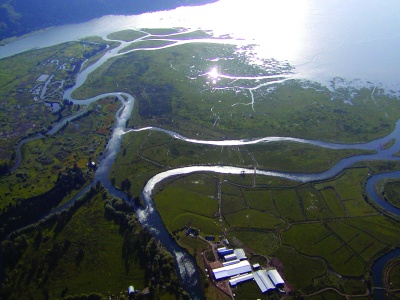Travelers to rugged Tillamook County are mostly left to their own imagination. There are no arcades, quaint downtowns, outlet malls or bustling bay fronts. Few hotels and no resorts. And only one man-made attraction to speak of, albeit a popular one: the cheese factory, up Highway 101 from windswept, quiet downtown Tillamook.
 An entrepreneurial group looks to nature-based tourism to diversify the economy.
An entrepreneurial group looks to nature-based tourism to diversify the economy.
By Oakley Brooks
Travelers to rugged Tillamook County are mostly left to their own imagination. There are no arcades, quaint downtowns, outlet malls or bustling bay fronts. Few hotels and no resorts. And only one man-made attraction to speak of, albeit a popular one: the cheese factory, up Highway 101 from windswept, quiet downtown Tillamook.
Most visitors come to run four-wheelers in the sand, hike along the rocky coast, then hole up in tents and vacation homes, or just leave. And for years, while places such as Cannon Beach and Astoria have been bending over backwards to accommodate tourists, local officials have cast a sleepy eye on Tillamook’s tourism trade. They’re content to rely on the dairy, timber and recreational fishing outfits to run the economy.
“I think we’ve just been laid back about it,” says Bob McPheeters, mayor of the city of Tillamook. “Traditionally, tourism has been less than 15% of the economy.”
But the people come anyway. And some tourism operators and entrepreneurs, having watched the increased number of kayaks, bikes and other toys coming over from Portland (affectionately called the “roof-rack effect”), want to exploit that interest and the area’s natural assets to accelerate the tourism industry in Tillamook County.
Marc Hinz, who owns the guiding company Kayak Tillamook County, is at the center of the new tourism efforts. Hinz figures the county’s hundreds of miles worth of river, estuaries, canals and calm bays can be leveraged into more local dollars. He’s predicting that with a little support from local leaders, the county could eventually attract 100,000 kayakers and other visitors. Hinz boldly compares Tillamook’s potential to Hood River, one of windsurfing’s world capitals. “You can get more diversity of paddling here than anywhere else in the world.”
It’s part of the push by local tourism operators and recreation groups for more “nature-based” tourism.
The goal is to help smooth out some of the local boom and bust cycles tied to Tillamook’s heavy reliance on natural resource industries. Local dairies have benefited from success of the Tillamook Cheese cooperative and the local timber industry recently has been revitalized. But the recreational fishing industry stands to take a hit this summer, as salmon season limits discourage anglers (the season is proceeding normally for other fishing). And local dairy farms are coming under steady pressure from environmental regulators to limit cow populations, and manure runoff, in the area.
Meanwhile, there are worrisome economic signs in the county. Poverty and underemployment run rampant while unemployment, at 6% for 2005 and early 2006, hovers above the state average. Wages are at three-fourths of the state average, and more than half of local school kids qualify for free or subsidized lunch, according to local economic development officials. A flood of wealthy second-home buyers has driven the average home price to close to $200,000, squeezing many locals out of the market.
So far, Hinz and others are struggling to show that turning Tillamook into a nature-based tourism capital will help. They’re trying to prove to local leaders that they’ll be able to develop a new industry with economic clout and attract the numbers of new visitors they’re claiming.
“I think they’re being a little overly optimistic,” says Chuck Hurliman, a Tillamook County commissioner. “I would say it’s not quite risen onto our radar yet.”
IN MID-APRIL, THE FLEDGLING nature-based tourism cluster gathers in Tillamook High School’s cafeteria for a small summit. But neither Hurliman, the more-supportive McPheeters, nor any of their colleagues in local office turn up (state Sen. Betsy Johnson does make an appearance.) Hinz is miffed, having rallied birding groups, a hang-gliding school and a sight-seeing boat captain, among others, to show off what’s up and running in the county. He’s also set to highlight a mapping effort by a local nonprofit of the region’s waterways, for paddlers interested in self-guided tours. He wonders aloud if political leadership will be interested in anything other than agriculture, logging and fishing.
“There’s a huge general population of people here who are more accepting of this stuff,” says Hinz, 36, a Portlander with a master’s degree in public administration who began teaching at the Tillamook Bay Community College in 2003.
Hinz would like to enlist local government support to invest in launch sites and restrooms and even bring in cell phone towers to keep contact with trips in the backcountry.
But lately, Tillamook commissioners have been focused on elevating tree harvest levels in the Tillamook State Forest and boosting the local timber industry. Log sales revenues from the forest, which sprawls across the eastern two-thirds of the county, provide roughly half of the $12 million county budget. The wood also fuels three local mills. Even with harvest levels below state targets, the recent mini-boom is big enough that mills are having a hard time filling job openings. An expected boost in harvest levels would not only fuel the industry, it would help pay for a rapidly deteriorating road system in the county.
“Timber makes up a good portion of our economy. How big depends on the level we’re harvesting at,” says Hurliman, a Tillamook native who worked for three decades as an engineer with the U.S. Forest Service and Bureau of Land Management.
Tillamook’s heavy reliance on traditional resource industries stands in contrast to other coastal counties, whose economies are now increasingly tied to tourism. In Lincoln County, for instance, hotel and other hospitality jobs grew 27% over the last decade, while jobs in forestry, wood products and fishing fell between 30% and 60%. Tillamook County grew its forestry and logging jobs and shrank its leisure workforce.
In Astoria, businesses and local officials have combined investments in older sectors with tourism; the town’s refurbished waterfront serviced by its trolley line also includes a new Bornstein Seafood factory.
Hurliman argues that continued support for the timber industry will deliver more “family-wage” jobs in mills, which he says are worth more than lower-paying positions in the tourism industry.
But that’s a presumption that Todd Davidson, the state’s tourism director, takes issue with. While he acknowledges that the tourism sector needs an abundance of housekeepers and wait staff, he says more than 70% of businesses in Oregon’s $7 billion tourism sector are sole proprietorships, which own all the profits of the operation.
“Those owners have an opportunity to earn a family wage,” Davidson says. “That often gets overlooked in this discussion.”
At Kayak Tillamook, Hinz, who started the business last June, has made an effort to push more profits to his staff by offering them ownership stakes in the company and paying his five guides $15-$30 an hour.
Hinz hopes more recreation will attract related light manufacturers to Tillamook to help expand the economy further, similar to the way Hood River windsurfers led equipment companies to set up shop there.
And he says more tourism would jibe with the city of Tillamook’s downtown revitalization, which includes a new library and Safeway. Additional visitors might spur hotel and restaurant development in town as well.
Tourism supporters in Tillamook are also making it clear that they’re not a front for an urban, environmentalist effort to undermine traditional industries. Dairies in the area have been the target of clean water suits by environmental groups and the tourism group carefully avoids using the term “ecotourism” to describe their activities. “It calls to mind tree huggers who don’t want any pollution in streams,” says Christy Vail, the director of the county’s economic development council, which is supportive of tourism efforts.
Hinz emphasizes coexistence with other industries.
“We can have kayaks and cows,” he says.
But Sen. Betsy Johnson notes that an economy’s transition toward more tourism will
inevitably encounter bumps along the way.
“I think the windsurfers in Hood River were first viewed with some hostility,” says Johnson, who represents the North Coast area. “But now they’re made to feel welcome and there’s a whole industry that’s cropped up around them. Bend has done the same thing with skiing.”
MARK WITTWER HASN’T SEEN THE BOTTOM LINE of new tourism in Tillamook pencil out yet, but he’s putting some skin in the game, believing that it will eventually. He and his wife joined up with Hinz recently to become shareholders in Kayak Tillamook. They’re contributing their guiding fees toward ownership equity. But while his wife is offering up much of her time to guide kayak trips, Wittwer has kept his day job farming oysters in Tillamook Bay and guides only occasionally.
“I wish I could work in kayaking fulltime but I need to pay the bills,” says the 48-year-old Wittwer, who was a commercial fisherman before turning to oysters around 1990. “We’re just building the business now.”
Wittwer thinks Hinz’s target of 100,000 new recreators a year in Tillamook County is reachable and that a more robust nature-based tourism industry could engage new second-homeowners and draw greater support for keeping wild places open or even buying them for parklands. Much of Tillamook’s waterfront property along rivers, sloughs and bayfronts is in private hands, but development there hasn’t overwhelmed the landscape.
“If we wait too long it’s going to be bought up by new owners and turned into trophy homes,” says Wittwer.
Hurliman agrees that a vibrant nature-based recreation will keep the county wild and open to a cross section of people. Local residents listed protection of wildlife habitat and related recreational opportunities as important in recent surveys by a citizen’s group, the Tillamook County Futures Council.
The widespread sentiment comes as two resort proposals, one near Sand Lake and another near the Tillamook airfield, vie to become the county’s only upscale destinations.
“Nature-based tourism is an important way to connect people to the environment,” Hurliman says. “If we don’t watch it, sooner or later we price ourselves out to the elite.” He says he would be open to a Futures Council recommendation to pursue more recreational
opportunities in the county.
“The difference of opinion right now,” Hurliman adds, “is at what level in the economy
nature-based tourism operates.”
But after a day of showing a small band of visitors around the city of Tillamook’s Hoquarton Slough, a paddling spot and site of a new city walking trail, Hinz seems even more convinced that his ideas for a new economic sector are ascendant.
“You can say you were here at the beginning,” he enthusiastically tells one visitor, “before this whole thing took off.”
Have an opinion? E-mail [email protected]




